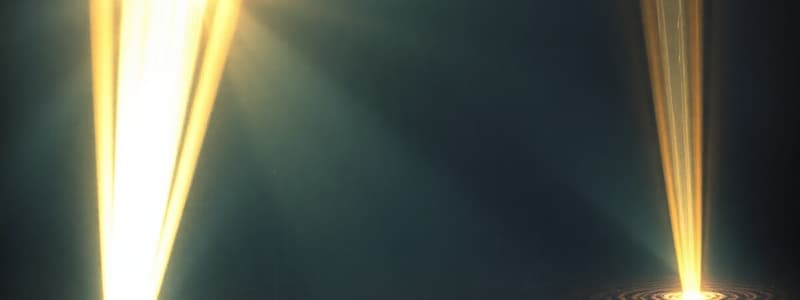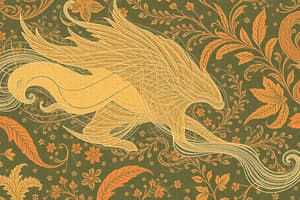Podcast
Questions and Answers
What are objects called that produce their own light?
What are objects called that produce their own light?
- Luminous bodies (correct)
- Opaque bodies
- Non-luminous bodies
- Translucent bodies
Which of the following is an example of a non-luminous body?
Which of the following is an example of a non-luminous body?
- The sun
- A burning candle
- An electric lamp
- The moon (correct)
What is the primary role of light in our ability to see?
What is the primary role of light in our ability to see?
- Light is not important for vision purposes.
- Light directly illuminates our eyes, creating vision.
- Light transforms objects into visible forms.
- Light makes objects visible by reflecting off them and reaching our eyes. (correct)
What is the process called when sunlight spreads in all directions by particles in the atmosphere?
What is the process called when sunlight spreads in all directions by particles in the atmosphere?
Which type of substance allows only some light to pass through it?
Which type of substance allows only some light to pass through it?
Which of the following best describes how light travels?
Which of the following best describes how light travels?
What is a group of light rays that originate from a source called?
What is a group of light rays that originate from a source called?
What is the darkest part of a shadow called?
What is the darkest part of a shadow called?
What is the main natural source of light on Earth?
What is the main natural source of light on Earth?
What is the name of the partial outer shadow?
What is the name of the partial outer shadow?
Flashcards
Light
Light
Energy that enables us to see.
Rectilinear Propagation of Light
Rectilinear Propagation of Light
Light travels in a straight path.
Umbra
Umbra
The fully dark region of a shadow.
Penumbra
Penumbra
Signup and view all the flashcards
Natural Light Sources
Natural Light Sources
Signup and view all the flashcards
Artificial Sources of Light
Artificial Sources of Light
Signup and view all the flashcards
Luminous Bodies
Luminous Bodies
Signup and view all the flashcards
Non-Luminous Bodies
Non-Luminous Bodies
Signup and view all the flashcards
Transparent Substance
Transparent Substance
Signup and view all the flashcards
Translucent Substance
Translucent Substance
Signup and view all the flashcards
Study Notes
- Light is crucial for making objects visible, traveling in a straight line, and casting shadows when it falls on an object.
- Planets and moons cast shadows in space, leading to eclipses.
Rectilinear Propagation of Light
- Light travels in straight lines.
- Evidenced by observing illuminated dust particles entering a dark room through a narrow opening.
- Stretching a thread along the path of a light ray demonstrates its straight-line trajectory.
Sources of Light
- Two types: natural and artificial.
- The sun is the primary natural light source for Earth.
- Stars are other natural sources, but their light is faint due to their distance.
- Fireflies emit natural light due to chemicals in their bodies.
- Artificial light sources include fire, electric bulbs and tubes, candles, kerosene lamps, and torches.
Luminous and Non-Luminous Bodies
- Luminous bodies emit their own light (e.g., the sun, stars, a burning candle).
- Non-luminous bodies become visible by reflecting light from luminous sources (e.g., the moon, Earth, a table).
- The moon reflects sunlight, making it visible from Earth.
Transparent, Translucent, and Opaque Substances
- Transparent substances allow light to pass through easily, enabling distinct vision (e.g., glass, air, water).
- Translucent substances allow partial light passage, resulting in a faint impression of objects (e.g., tracing paper, waxed paper).
- Opaque substances block all light, preventing any vision through them (e.g., wood, metal sheets, black paper).
Ray and Beam of Light
- A ray of light is a straight line path of light emanating from a point source.
- A beam of light is a group of light rays.
- Parallel beam: Light rays are parallel to each other, originating from a distant source.
- Divergent beam: Light rays spread out from a point source.
- Convergent beam: Light rays converge towards a point.
Applications - Rectilinear Propagation of Light
- Pinhole cameras, formation of shadows, and eclipses demonstrate this principle.
Pin Hole Camera
- Simple device demonstrating rectilinear light propagation. Works by light traveling in straight lines through a pinhole to project an inverted image.
- The size of the image depends on the distance of the screen from the pinhole and the distance of the object from the pinhole.
- Increasing the distance of the screen from the pinhole increases the image size
- Moving the object away from the pinhole decreases the image size.
- Creating another pinhole near the first results in overlapping, blurred images.
Shadows
- Formed when an opaque object blocks light, creating a dark patch.
- Umbra: The completely dark portion of a shadow where no light reaches from the source.
- Penumbra: The partially dark area around the umbra where some light reaches.
- Umbra forms with a point light source.
- Both umbra and penumbra form with an extended light source like a candle.
- Closer screen distances reduce shadow size.
Eclipses
- Lunar eclipses occur when Earth casts a shadow on the moon.
- Solar eclipses occur when the moon casts a shadow on Earth.
- Total lunar eclipse: Earth completely blocks sunlight from reaching the moon.
- Partial lunar eclipse: Only part of the moon passes through Earth's penumbra.
- Total solar eclipse: The moon completely blocks the sun's light from a specific area on Earth.
- Annular solar eclipse: The moon appears to obstruct the sun, with only the outer rim (corona) visible.
Studying That Suits You
Use AI to generate personalized quizzes and flashcards to suit your learning preferences.
Description
Light travels in straight lines and is crucial for visibility and shadow formation. Sources of light are categorized as natural (e.g., the sun and stars) or artificial (e.g., electric bulbs). Luminous bodies emit light, while non-luminous bodies reflect it.



